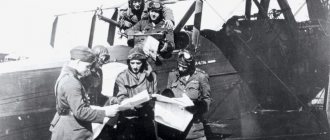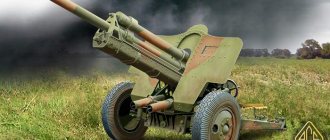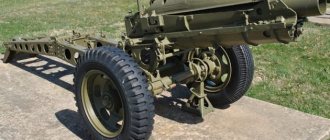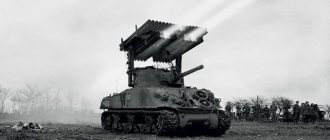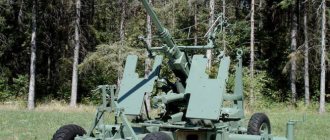ZiS-2
The 57-mm anti-tank gun of the 1943 model is a weapon with a very difficult fate. One of two anti-tank guns of the USSR during the Great Patriotic War (the second was the famous “magpie”). This system appeared back in 1941, but then there were simply no worthy targets for this weapon. It was decided to abandon the production of a complex and expensive weapon. We remembered the ZiS-2 in 1943, when the enemy acquired heavy equipment.
57-mm anti-tank gun ZiS-2 model 1943 (northern line.rf)
For the first time, the ZiS-2 of the 1943 model appeared at the front in the summer of 1943 on the Kursk Bulge and subsequently proved themselves to be quite good, coping with almost any German tanks. At distances of several hundred meters, the ZIS-2 penetrated the 80-mm side armor of the Tigers. In total, more than 13 thousand ZiS-2 were produced during the war years.
Artillery of the Red Army
Home » Alternatives to World War II » Artillery of the Red Army
Alternatives to World War IIAlternatives to World War II
admin 09/11/2012 1788 141
0
in Favoritesin Favoritesfrom Favorites 0
Already at 30. during the modernization of the 76-mm divisional gun of the 1902 model. it became clear that the gun was outdated. And although by lengthening the barrel it was possible to increase the initial flight speed of the projectile from 610 to 655 m/sec, it was clear that this was nothing more than a temporary measure, because the resulting initial speed value was clearly insufficient compared to foreign analogues. For 76mm divisional guns of that time, 700-750m/sec was required, no less. The main problem with the domestic three-inch gun was the outdated ratio of weight and caliber of the projectile, the amount of gunpowder in the artillery cartridge (1.08 kg) and, as a consequence, the length of the gun barrel.
It was from the beginning of the 30s that an active search for ways and methods to solve the problem began. The fact is that there were three main ways to solve the problem:
1. Make a new gun using new ammunition from scratch. However, the warhead of the artillery cartridge (the projectile) could have been left the same.
2. Lengthen the gun barrel by changing the rifling angle.
3. Reduce the caliber of the gun by replacing only the barrel and the warhead of the artillery cartridge in production. Everything else, however, remained the same.
All these methods had both their advantages and very significant disadvantages:
1. The most effective, but also the most expensive method. In the production of old 76mm ammunition, only the warhead of the artillery cartridge remained unchanged. Which, in fact, was almost equivalent to the production of new ammunition.
2. This is exactly what was done in 1930. during the modernization of the 76-mm divisional gun model 1902 (three-inch). The method is certainly tempting, but not very effective. It would not be possible to greatly increase the initial speed of the projectile in this way again. And this time the carriage had to be made new, the old one would no longer stand it. In addition, there were technological difficulties, the length of the barrel of the 76-mm divisional gun of the 1930 model. at 3048mm was close to the technological limit of conventional cannon factories of those years, which was 3200mm. 3. The previous amount of gunpowder in the new artillery cartridge became sufficient for a lighter projectile, which made it possible to accelerate it to a higher initial speed. The disadvantage of this method was that it was necessary to start producing a new warhead of the artillery cartridge, which, however, was relatively inexpensive. In addition, a decrease in caliber led to a decrease in the power of the OFB. Which, strictly speaking, is not a disadvantage for a gun, unlike a howitzer. At the same time, the power of the BB increased.
76mm divisional gun mod. 02/30
The consequence of discussions on this topic was that, having considered these options, the GAU came to the conclusion that option No. 2 was appropriate. Moreover, the chief designer of the industry’s leading plant No. 92 in Gorky, Grabin, assured everyone everywhere that there would be no problems with the production of longer barrels at his plant.
At 35 Three new experimental guns were built and tested. Their barrel length was 3895 mm, the initial velocity of the projectile was 710 m/sec., i.e. The plant coped with the task quite well. But it would be more correct to say how I would have coped. Because these guns used completely non-standard, custom-made artillery cartridges. Simultaneously with the adoption of the new gun, the plant recommended adopting a new 76mm artillery cartridge, which was completely unacceptable for the GAU for economic reasons. Actually, plant No. 92 proposed to act according to option No. 1, contrary to the opinion of the GAU that only option No. 2 was possible.
As a result, Gorky’s comrades were corrected; in the pre-production batch, the barrels and barrel rifling were changed to fit a standard 76-mm shot with a mod. 1900 GAU did not want to give up this cartridge for economic reasons, because Very significant capacities were involved in its production in the USSR. The initial velocity of the projectile on this artillery cartridge was 690 m/sec, which was slightly lower than required. Despite this, on May 11, 1936. The F-22 was put into service under the name “76-mm divisional gun mod. 1936" and put into mass production. In other words, option No. 2 also did not work out; in fact, it was a completely new product, but using old ammunition for firing.
76mm divisional gun mod. 36 F-22
And after that, something began that I would like to call the word circus, but it just won’t work. It turned out that when Grabin assured everyone that there would be no problems with the production of long barrels, he, as it would be more correct to say, slightly exaggerated.
The production of the F-22 at three factories was fraught with incredible difficulties. And first of all, this was due to the fact that the production of serviceable barrels was accompanied by a huge amount of defects, which, in turn, repeatedly increased the cost of serviceable guns. At 36 not a single cannon was fired. At 37 all three manufacturing plants produced only 417 usable guns in 1938. 1002 usable guns. After graduation in '39. Another 1503 guns, their production was discontinued as completely unprofitable.
At plant No. 92 alone, in three years, three plant directors were repressed as pests and saboteurs. We will never know how many technologists, engineers and workers were repressed; it is not customary for us to count them. And these are all victims of Grabin’s ambitions.
When already at the end of 38. It became finally clear that the F-22 had to be removed from production, and the question of its replacement arose. At the beginning of '39 GAU was presented with two projects. The first was provided by Grabin. Its gun was called F-22-USV and was, to put it very briefly, the same F-22, but with a barrel of “technological” length of exactly 3200 mm. The initial flight speed of the projectile was 655m/sec, which is 39g. was catastrophically small; for this caliber then about 750-800 m/sec was already required. In other words, at the cost of incredible efforts and expenses in 1939. The Red Army was proposed to return to the three-inch model. 30, but in a new way. This, of course, was completely unacceptable.
And the 85mm F-22/85 divisional gun went into production, which was obtained by replacing the F-22 barrel with an 85mm caliber barrel with a length of 37.5 klb. (3188mm). To reduce the recoil force, a muzzle brake was applied. The initial speed of the projectile was 735 m/sec, which was already quite normal. For this caliber in those years the norm was 700-750m/sec. At the same time, the chamber was made to the size of a powerful artillery cartridge (powder charge 2.48-2.60 kg) from an 85mm anti-aircraft gun mod. 39 52-K with a barrel length of 55.2 klb (4692 mm). The weight of the gun in firing position was 1600 kg, which is even slightly less than the weight of the F-22.
85mm divisional gun mod. 39 F-22/85
This was done deliberately, with a view to the future. And so it happened, in '43. from the F-22/85 the ZIS-3/85 model “grew”. 43 with a barrel length of 51.6 klb. (4386mm). And at 44 The barrel length of the ZIS-3/85 was increased to 54.6 klb. (4641mm). The gun was designed by a separate design group under the new director of plant No. 92, who really did not want to repeat the path of the previous three. Therefore, the group was immediately given a very specific task, to increase the power of the divinity gun with serial ammunition, leaving the barrel no longer than 3200mm. The new plant director quite rightly did not trust Grabin.
85mm divisional gun mod. 43 ZIS-3/85
Tank guns were made based on the F-22/85 of different years of production. Heavy tank KV-1 mod. 42g. received the F-22/85T tank gun, made on the basis of the F-22/85. For the experienced average KV-1s (ChTZ) at the end of 42. The D-5T was intended to be based on a gun with a length of 51.6klb, and the average KV-1s/85 was 43g. received the S-53 tank based on a 54.6 klb long gun. You can read more about Red Army tanks here:
Medium tank KV-1s/85 mod. 43 with 85mm S-53 cannon
Also, divisional artillery in those years included a 122mm howitzer mod. 38 M-30.
Regimental guns
76mm regimental gun model 27g.
Things were a little different with the regimental 76mm gun mod. 27 52-P-353. The fact is that in 1938. The Red Army was supposed to receive a fairly powerful 120-mm regimental mortar mod. 38 with a mine, which in terms of explosive power was far behind a 76mm artillery shell. Therefore, in ’37. it was decided to strengthen the anti-tank component of the regimental artillery. To do this, it was necessary to make a new gun, because... the universal 52-P-353 was clearly absolutely unsuitable for anti-tank purposes. This time, again in order to save money, the GAU leadership decided to take a third route. Those. change the caliber of the barrel and warhead of the artillery cartridge, leaving all other parts unchanged. The 76-mm mountain gun mod. 38 the “native” barrel was replaced with a 65mm barrel with a length of 49.1 klb. (3194mm). The initial projectile speed of such a gun was 804 m/sec, which was quite acceptable for that time. To reduce the recoil force, the portable version of the gun was equipped with a muzzle brake. Wheel suspension was also added, and the ability to disassemble the gun was eliminated. The new gun was named 65mm regimental gun mod. 38 S-5/65. Its weight in combat position was about 900 kg, which was even slightly less than that of the previous regimental gun weighing 920 kg.
76mm mountain gun mod. 38 S-5
In addition to this option, there was also the option of replacing the barrel with subsequent lightening of the carriage for the F-22. This pre-production model was called F-22/65. The lightweight carriage from the F-22 made it possible to do without a muzzle brake, but the weight of the gun in the firing position was 1.4 tons. As a result, this option was rejected and the lighter S-5/65 went into production.
65mm regimental gun F-22/65 (did not go into production)
The tank version of the regimental gun, which was called S-5/65T, was armed with heavy tanks KV-1/65 mod. 40g. and medium tanks T-34/KVl mod. 41-42 These guns were not equipped with a muzzle brake.
T-34/KVl arr. 42g. with 65mm S-5/65T cannon
Here it would also be useful to note that it was the regimental S-5/65 and the tank S-5/65T that bore the main anti-tank load in the summer of 41. With good ballistic performance, the divisional F-22/85 was relatively few in number, and the battalion M-37 had insufficient power to effectively counter the latest German tanks. And she could only act against them from artillery ambushes or from “pistol” ranges. However, against the main part of German armored vehicles, the M-37 was quite effective at all distances of real combat.
The S-5/65 was not further modernized until the end of the Second World War, because further improvement of its ballistic characteristics inevitably entailed an increase in weight, which was undesirable. However, there are cases when, due to a lack of S-5/65, regimental artillery was replenished with ZIS-2/65 guns using the same ammunition.
At 38 based on ammunition for the S-5/65 by upgrading the 76mm anti-aircraft gun mod. 31 (3-K) a new 65mm anti-aircraft gun of sample 38g was created. (65-K), which was subsequently produced at specialized plant No. 8 in Podlipki near Moscow. With a barrel length of 67 klb. (4357mm) the projectile in it accelerated to a speed of 846m/sec. This gun was lighter and more mobile than the 85mm anti-aircraft gun mod. 39 52-K. Thus they complemented each other perfectly. Anti-aircraft guns of 76mm caliber after 38. no longer released.
65mm anti-aircraft gun mod.
38 65-K Battalion Guns
At the end of '36 it was decided to increase the power of the 45mm anti-tank gun mod. 32g. 19-K, because its power, as the experience of its use in Spain showed, no longer fully met the requirements of the time. In addition, serious mistakes were made during its design. What was good for the 37mm Rheinmetall turned out not to be very good for the 45mm anti-tank gun. Having already been burned once by the example of the F-22, this time the GAU leadership decided to take the cheapest route of all possible. The design bureau of the plant producing 19-K was ordered to simply lengthen the barrel to 68.6 klb. (3087mm) and that's it. As subsequent measurements showed, with a barrel of this length on standard ammunition, the initial projectile flight speed was 825 m/sec. Of course, in those years this was not enough for such a caliber, but it turned out to be very cheap. The semi-automatic shutter was also redesigned, suspension of new car wheels from GAZ-AA was added, the machine was slightly redesigned and strengthened, and the turning mechanism was redesigned.
It must also be said that at the same time the anti-tank artillery of the Red Army was completely eliminated in the USSR. 45mm cannon paired with an 82mm battalion mortar mod. 36 Since then they have constituted battalion artillery of rifle units. The new gun was put into service as a 45mm battalion gun mod. 37 M-37.
Next year, 38 The 45mm 20-K tank gun was also modernized. This time, the matter was not limited to simply lengthening the barrel, by analogy with the M-37; the gun also received new, more powerful ammunition. The amount of gunpowder in a standard 45mm artillery cartridge was increased from 0.36 to 0.39 kg. Tank guns of this model were called VT-38. They were armed with light tanks T-26, partly BT-7 mod. 37g., BT-7M, T-70 and medium T-34/45.
45mm anti-tank gun mod. 37 M-37
Since 39 All units armed with 45mm battalion guns began to receive new type ammunition. The ballistic characteristics of the guns on this cartridge have changed quite significantly, so from this year the M-37 guns began to be called M-37/39. The initial projectile speed of this gun was 870 m/sec.
Medium tank T-34/45 with 45mm VT-38 cannon
The M-37/39 was produced until 1943, after which it was once again modernized. The length of the gun barrel was increased to 89.6 klb. (4033mm). Its initial projectile speed was 910m/sec. In addition, the shield's armor has been strengthened. The gun was put into service as a 45mm battalion gun mod. 43 M-43. Its weight in combat position was 700 kg. It was produced in this form until the end of the Second World War. A tank version of this gun was not developed or produced.
Anti-tank guns
65mm anti-tank gun mod. 43 ZIS-2/65
At 43 Anti-tank fighter regiments and brigades were created in the Red Army, which received specialized anti-tank guns made on the basis of the regimental S-5/65, whose barrel was replaced by a barrel from a 65mm anti-aircraft gun mod. 38 (65-K) 67klb long. (4356mm). The gun also received a new lightweight carriage with sliding frames, which was made by the ZIS plant based on the carriage from the ZIS-3/85. Therefore, her weight in the combat position did not change much and amounted to 1100 kg. The initial flight speed of the projectile was already 860m/sec. As an alternative, the ZIS plant provided its development, the 57mm ZIS-2 anti-tank gun on the same carriage. As a result of comparative tests, it became clear that the 57mm gun is inferior to the 65mm in many respects, including. in terms of OFB power, although it is somewhat superior in armor penetration. In addition, the adoption of a new caliber gun is always associated with a host of various kinds of difficulties, which was extremely undesirable during the war. As a result, it was decided to adopt a 65mm cannon. Since it was produced at the ZIS plant, it went into production under the name ZIS-2/65. These guns in the tank version (ZIS-4/65) were armed with the T-34/KVl light tanks mod. 43-44
T-34/KVl arr. 44 with 65mm ZIS-4/65 cannon
To summarize, we can say that by 1939. The Red Army has completely renewed its fleet of field and large anti-aircraft artillery. Moreover, modern tank guns were made on the basis of field guns, which were used to arm Red Army tanks from the late 30s. Which came in handy very soon, in the early 40s. And later anti-aircraft guns were adapted for installation in tanks.
By trial and error in 1943. The SA came up with a regimental, anti-aircraft and anti-tank gun using the same ammunition. It was a cartridge mod. 1900 from 76mm “three-inch” with a warhead caliber reduced to 65mm. This cartridge was called 65mm artillery cartridge mod. 38 The weight of a projectile of this caliber was 4.5 kg, and the entire artillery cartridge weighed 7.2 kg.
There has also been some "standardization" in the use of larger caliber ammunition. All 85mm caliber guns used an interchangeable range of ammunition based on ammunition from the anti-aircraft gun mod. 39 The weight of the warhead of the 85mm armor-piercing projectile was 9.2 kg.
More information about tanks and their weapons can be found here:
Now about the numbers. I will try to explain in detail. For the already low-power 76.2mm artillery cartridge arr. in the mid-30s. 1900 There were several criteria for barrel length:
1. Optimal
– barrel length is about 30klb.
(around 2300mm) with a caliber of 76.2mm. The best barrel in this category was the L-11 cannon barrel with a length of 30.5 klb. (2324mm). Grabin “quietly admitted” this at one time when he made the ZIS-2 by converting the L-11, and not his F-32, to 57mm caliber. Don't believe me? Take a calculator and do the math yourself. Be surprised. Yes, yes, the ZIS-2 is still the same L-11, but in 57mm caliber. And the S-5/65 (65mm) is the same L-11 (76.2mm) or ZIS-2 (57mm), but recalculated to the real and manufacturable pre-WWII channel length, which mass-produced deep-drilling machines could handle in those days . Namely up to 3200mm. Don't believe this figure? Look how long Grabin is in 39g. cut off the barrel of the F-22 to get the technologically advanced F-22-USV. Improved manufacturability, ballistics collapsed. From a projectile weighing 6.3 kg. on a 76.2mm cartridge case model 1900. with a low-power charge of gunpowder of 1.08 kg. At that time it was no longer necessary to leave, it was necessary to run away. I would suggest running with a 65mm caliber. weighing 4.5 kg. This is the maximum that could be squeezed out of the amount of gunpowder in the cartridge case and the manufacturability of the barrel in the late 30s. 2. Maximum
– barrel length is about 40klb.
(about 3100mm) with a caliber of 76.2mm. The best example of a barrel in this category is the F-34 with a barrel length of 41.5 klb. (3162mm). L-15 lost the tender this time. ZIS-2/65 is the same F-34 converted to 65mm caliber. Moreover, it was recalculated and made in 43, when the restrictions on barrel length became less strict. The barrel is 67klb long. (4357mm) with a caliber of 65mm in 43g. was already quite technologically advanced. And 65-K was initially made in Podlipki, at the specialized “anti-aircraft” plant No. 8. Grabinskaya ZIS-2 with a caliber of 57mm and a barrel length of 73klb. (4161mm) even in 43g. was complete nonsense (there are no doubts about 41). The power of its warhead was significantly less than that of the ZIS-2/65, and there was no longer any possibility of modernization. Well, who would make a 99klb long barrel for it. (5662mm)? 3. Wrecker
- trunk length more than 42 klb. (3200mm). There is not much to say here, just look at the example of the F-22 with a barrel length of 51.1 klb. (3895mm). Or on the ZIS-2 in 1941, this Grabinsky rake No. 2. Before the Second World War, barrels with a length of more than 3200 mm could be inexpensively and en masse produced at a limited number of specialized (mainly anti-aircraft) factories. Also, those who like to count length not in mm, but in calibers should remember that although the barrel length of the Mosin rifle mod. 19th century was a terrible 105 caliber, but in mm. it was of acceptable length, 800mm. And this is precisely what has allowed it to be done en masse ever since.
Colleagues, please note that the numbers for virtual guns in the table were calculated as carefully as possible. I even tried to take into account the friction area of the projectile in the barrel bore. So they are quite consistent with what could be obtained in reality.
Below I provide data on real artillery of the Red Army and comparable armor of German tanks
ZiS-3
The most popular Soviet weapon of the Great Patriotic War was the ZiS-3 (76-mm divisional gun model 1942), which began to enter the active army in the second half of 1942.
76mm ZIS-3 cannon. (waralbum.ru)
The first mass combat use of this weapon is presumably associated with the battles in the Stalingrad and Voronezh directions. The light and maneuverable cannon was used to combat both enemy personnel and equipment. In total, more than 100 thousand ZiS-3s were produced - more than all other guns combined during the war. The ZiS-3 was produced at enterprises in Gorky (modern Nizhny Novgorod) and Molotov (modern Perm).
"Door knocker" of the Wehrmacht
The ancestor of modern anti-tank guns can be considered the 37 mm caliber gun , created in 1928. In the mid-1930s, a modernized gun, called 3.7 cm PaK 35/36 , went with German artillerymen to Spain - to help the supporters of General Franco. Light and therefore maneuverable, the PaK 35/36 had no problems hitting light T-26 and BT tanks that fought in the Republican army – Franco’s opponents – with high-speed shells. German generals decided that the 37 mm caliber would be enough for the coming “big war,” and Germany entered World War II with 11,000 PaK 35/36 guns.
Anti-tank gun 5.0 cm PaK 38. Germany
Some problems for German anti-tank tanks arose in 1940 - the British Matilda tanks and French Somois tanks with 35-40 mm armor were no longer so easily penetrated by a 37 mm projectile. But they did not stop the advance of the German army, and the command did not worry. The Germans entered the USSR with 15,000 Pak 35/36. And then it turned out that a 37-mm projectile could only “knock politely” on the armor of the T-34 and KV. Dissatisfied German artillerymen called the gun a “door knocker”, and by the beginning of 1942 its production had ceased. In return, they increased the production of the 5.0 cm PaK-38 , which appeared on the eve of World War II.
ML-20
The 152 mm howitzer-gun of the 1937 model is a unique weapon that combines the firing range of a cannon and the ability of a howitzer to fire along a hinged trajectory. During the Great Patriotic War, not a single army in the world, including the German one, had such systems. Not a single major artillery preparation could take place without the ML-20, be it the Moscow, Stalingrad or Kursk battles.
152-mm howitzer gun model 1937. (warbook.info)
It is noteworthy that the ML-20 became the first Soviet weapon to open fire on German territory. On the evening of August 2, 1944, about 50 shells were fired from the ML-20 at German positions in East Prussia. And immediately a report was sent to Moscow that shells were now exploding on German territory. Since the middle of the war, the ML-20 was installed on both the Soviet self-propelled guns SU-152 and later on the ISU-152. In total, about 6,900 ML-20 guns of various modifications were produced.
"Magpie"
The 45-mm anti-tank gun of the 1937 model was the main anti-tank weapon of the Red Army in the initial period of the war and was capable of hitting almost any German equipment. The military debut of this gun took place somewhat earlier - in the summer of 1938, when the "magpies" were used to destroy enemy firing points during the battles on Khasan, and a year later they shocked Japanese tank crews at Khalkhin Gol.
Crew of a 45-mm anti-tank gun, model 1937. (armorboy.ru)
Since 1942, its new modification (45-mm anti-tank gun model 1942) with an elongated barrel was adopted for service. Since the middle of the war, when the enemy began to use tanks with powerful armor protection, the main targets of the “magpies” were transporters, self-propelled guns and enemy firing points. On the basis of the “magpie”, a 45-mm semi-automatic naval anti-aircraft gun 21-K was also created, which turned out to be ineffective due to the low rate of fire and the lack of special sights. Therefore, whenever possible, the 21-K was replaced with automatic guns, transferring the removed artillery to strengthen the positions of ground troops as field and anti-tank guns.
Anti-tank self-propelled guns (SU)
Victory over the Poles in 1939, however, did not prevent the Germans from seeing how weak their own tanks were. Especially in the fight against enemy tanks. Therefore, before the attack on France in 1940, the Wehrmacht tank divisions were replenished with Czech 47-mm anti-tank guns mounted on the chassis of the Panzer I tank. The result was a good anti-tank self-propelled gun Panzer Jager I, which, following in the ranks of German tanks, could immediately support them with its more powerful fire.
It was not so much the Soviet tanks that became truly disastrous for the Panzer Jager, but also the Russian open spaces with off-road conditions. The chassis from the Panzer I broke down even on the Austrian autobahns in 1938, and now it completely failed on Russian roads
But if in France the new control system somehow managed to cope with its tasks, then the war in Russia put an end to its combat career. The scale and grandeur of the battles turned out to be different. Therefore, in 1942, it was replaced by a whole family of anti-tank SU “marder” (marten), with a 75-mm cannon, which were produced until the very end of the war.
The 75-mm anti-tank gun, mounted on a chassis from a French tractor, laid the foundation for a whole family of self-propelled guns called “martens”. "Marder" I is a control system based on French cars
“Marder” II is a control system based on the German Panzer P tanks. The first 210 anti-tank self-propelled guns, armed with Russian 76-mm F-22 cannons, were built on the chassis of the new Panzer II D or converted from Flammpanzer II flamethrower tanks
"Marder" III is a control system based on the Czech LT-38 tanks. The “marten” drawn on the left was armed with the Russian F-22 cannon, and the one drawn on the right was armed with the German Pak 40. “Marder” III became the most popular anti-tank control system of the Wehrmacht. Almost 2 thousand of these self-propelled guns were built.
"Hornet" is the most powerful anti-tank gun of the Wehrmacht. It is armed with a six-meter 88-mm cannon
52-K
During the Great Patriotic War, this weapon was very widely used both at the front and to protect rear facilities and large transport hubs. During combat operations it was often used as an anti-tank weapon. And before the start of mass production of the BS-3, it was practically the only gun capable of fighting German heavy tanks at long distances.
85-mm anti-aircraft gun model 1939. 1941. (howlingpixel.com)
There is a well-known feat of the crew of Senior Sergeant G. A. Shadunts, who destroyed 8 German tanks in two days of fighting in the area of the modern city of Lobnya, Moscow Region. The feature film “At Your Doorstep” is dedicated to this episode of the battle of Moscow. K. K. Rokossovsky later recalled about another example of successful actions of Soviet anti-aircraft gunners who destroyed a German column with 85 mm gun fire on the Lutsk-Rovno road: “The gunners let the fascists get closer and opened fire. A monstrous traffic jam formed on the highway from the wreckage of motorcycles and armored vehicles, and the corpses of Nazis. But the advancing enemy troops continued to move forward by inertia, and our guns received more and more targets.”
B-34
The universal 100 mm naval artillery mount on Soviet ships (for example, Kirov-class cruisers) was used as long-range anti-aircraft artillery. The gun was equipped with an armor shield. Firing range 22 km; ceiling - 15 km. Each of the Kirov-class cruisers was supposed to carry six 100 mm universal guns.
100 mm B-34 naval gun. (tury.ru)
Since it was impossible to track the movement of enemy aircraft with heavy guns, firing, as a rule, was carried out in curtains at a certain range. The weapon also turned out to be useful for hitting ground targets. In total, 42 guns were produced before the start of World War II. Since production was concentrated in Leningrad, which was under siege, the Pacific Fleet cruisers Kalinin and Kaganovich were forced to equip not 100-mm, but 85-mm cannons as long-range anti-aircraft artillery.
One of the most effective stationary Soviet batteries was the 394th battery of four 100-mm guns, located on Cape Penay (the area of modern Kabardinka) under the command of Lieutenant A.E. Zubkov. Initially, it was built to repel a possible attack from the sea, but since 1942 it has successfully operated against ground targets. In total, during the battles, the battery carried out 691 firings, firing more than 12 thousand shells.
The battery was subjected to massive enemy artillery and air strikes. The crews suffered serious losses, and the guns were constantly damaged; Gun barrels and armor shields were replaced several times. A unique case was when a German shell hit the gun barrel directly through the muzzle, but, fortunately, did not explode (this episode was independently confirmed after the war by the battery commander and mechanic). In 1975, a museum and memorial complex was opened on the site of the legendary battery.




